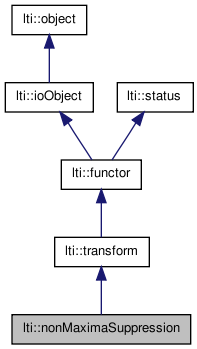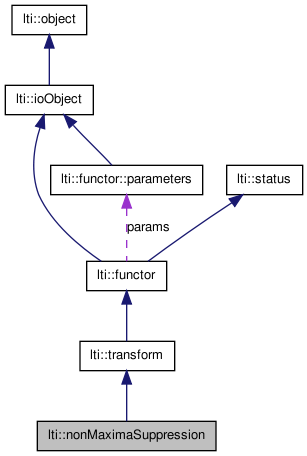

|
latest version v1.9 - last update 10 Apr 2010 |
|
The non-maxima suppression is usually the last stage of edge detectors (the most prominent example is the Canny Edge Detector, see lti::cannyEdges), but it can also be employed in other similar tasks, like detection of saliency edges from "structural" saliency maps (see for example lti::guyMedioniSaliency). More...
#include <ltiNonMaximaSuppression.h>


Classes | |
| class | parameters |
| the parameters for the class nonMaximaSuppression More... | |
Public Member Functions | |
| nonMaximaSuppression () | |
| nonMaximaSuppression (const parameters &par) | |
| nonMaximaSuppression (const nonMaximaSuppression &other) | |
| virtual | ~nonMaximaSuppression () |
| virtual const char * | getTypeName () const |
| bool | apply (const channel &preedges, const channel &orientation, channel8 &edges, const float maxPreedge=1.0f) const |
| bool | apply (const channel &preedges, const channel &orientation, const channel &relevance, channel8 &edges, const float maxPreedge=1.0f) const |
| nonMaximaSuppression & | copy (const nonMaximaSuppression &other) |
| nonMaximaSuppression & | operator= (const nonMaximaSuppression &other) |
| virtual functor * | clone () const |
| const parameters & | getParameters () const |
Protected Member Functions | |
| float | interpolate (const float y1, const float y2, const float fOffset) const |
| void | nonMaxSuppression (const channel &preedges, const channel &orientation, channel8 &edges, const float thresholdMin) const |
| void | hysteresis (const channel &preedge, const channel8 &maxima, const float thresholdMax, channel8 &dest) const |
| void | thresholdValues (const channel &grad, const float maxGrad, float &thresholdMin, float &thresholdMax) const |
| void | checkOrientation (const channel &src, channel &dest) const |
| int | findEndPoints (const channel8 &src, channel8 &endPts, pointList &endPtsList) const |
| bool | trackPoints (const channel8 &edges, const pointList &endPtsList, const channel &orientation, tpointList< float > &deltas) const |
| bool | fillGaps (const channel8 &edges, const channel &gradMag, const pointList &endPtsList, const tpointList< float > &deltas, channel8 &dest) const |
The non-maxima suppression is usually the last stage of edge detectors (the most prominent example is the Canny Edge Detector, see lti::cannyEdges), but it can also be employed in other similar tasks, like detection of saliency edges from "structural" saliency maps (see for example lti::guyMedioniSaliency).
From a sort of "diffuse edge" channel, this functor tries first to find all local maxima, and suppresses the rest. In an optional hysteresis stage, neighbor pixels of detected maxima can also "survive" the suppression if their value exceeds a lower threshold value.
A similar class used in detection of local maxima is the lti::localMaxima.
There are two way to given the thresholds. The classical way is to give them as a percentage of the maximal pixel value found in the image. This is the way usually described in the text-books when describing the last stages of the Canny Edge Detection.
This functor provides an additional (sometimes more robust way) to select the thresholds. It is an indirect way that computes the threshold such that a given percentage of the total number of pixels have a value above it. It is a way to tell the functor your expectation how many pixels in an image will be considered edges, instead of telling which value the edges will have.
Some parameters will allow you to select which way of threshold computation you prefer for the low- and high-thresholds.
| lti::nonMaximaSuppression::nonMaximaSuppression | ( | ) |
default constructor
| lti::nonMaximaSuppression::nonMaximaSuppression | ( | const parameters & | par | ) |
Construct a functor using the given parameters.
| lti::nonMaximaSuppression::nonMaximaSuppression | ( | const nonMaximaSuppression & | other | ) |
copy constructor
| other | the object to be copied |
| virtual lti::nonMaximaSuppression::~nonMaximaSuppression | ( | ) | [virtual] |
destructor
| bool lti::nonMaximaSuppression::apply | ( | const channel & | preedges, | |
| const channel & | orientation, | |||
| const channel & | relevance, | |||
| channel8 & | edges, | |||
| const float | maxPreedge = 1.0f | |||
| ) | const |
operates on a copy of the given parameters.
| preedges | channel containing pre-edges, i.e. only some confidence values are expected, where the maxima represent edges. Only those values greater than thresholdMax times the maximum value here will be considered. | |
| orientation | channel with the angles. It is an angle in the image coordinate system, i.e. a positive angle direction is clockwise. The units must be radians and the values MUST be zero or * positive between 0.0f and 2*Pi. See documentation of * parameters::checkAngle for more information. | |
| relevance | the thresholds will be computed "dividing" the ones given in the parameters by the corresponding element in this channel. | |
| edges | After the suppression, only the edges will be left. | |
| maxPreedge | Optional argument. The algorithm uses as maximum threshold the given parameters::maxThreshold multiplied by this argument. It is usally employed to give here the maximum of the preedges, which may be computed previously. |
| bool lti::nonMaximaSuppression::apply | ( | const channel & | preedges, | |
| const channel & | orientation, | |||
| channel8 & | edges, | |||
| const float | maxPreedge = 1.0f | |||
| ) | const |
operates on a copy of the given parameters.
| preedges | channel containing pre-edges, i.e. only some confidence values are expected, where the maxima represent edges. Only those values greater than thresholdMax times the maximum value here will be considered. | |
| orientation | channel with the angles. It is an angle in the image coordinate system, i.e. a positive angle direction is clockwise. The units must be radians and the values MUST be zero or * positive between 0.0f and 2*Pi. See documentation of * parameters::checkAngle for more information. | |
| edges | After the suppression, only the edges will be left. | |
| maxPreedge | Optional argument. The algorithm uses as maximum threshold the given parameters::maxThreshold multiplied by this argument. It is usally employed to give here the maximum of the preedges, which may be computed previously. |
| void lti::nonMaximaSuppression::checkOrientation | ( | const channel & | src, | |
| channel & | dest | |||
| ) | const [protected] |
ensure that the angles are between 0.0f and 2*Pi.
| virtual functor* lti::nonMaximaSuppression::clone | ( | ) | const [virtual] |
returns a pointer to a clone of this functor.
Implements lti::functor.
| nonMaximaSuppression& lti::nonMaximaSuppression::copy | ( | const nonMaximaSuppression & | other | ) |
copy data of "other" functor.
| other | the functor to be copied |
Reimplemented from lti::functor.
| bool lti::nonMaximaSuppression::fillGaps | ( | const channel8 & | edges, | |
| const channel & | gradMag, | |||
| const pointList & | endPtsList, | |||
| const tpointList< float > & | deltas, | |||
| channel8 & | dest | |||
| ) | const [protected] |
fill the gaps
| int lti::nonMaximaSuppression::findEndPoints | ( | const channel8 & | src, | |
| channel8 & | endPts, | |||
| pointList & | endPtsList | |||
| ) | const [protected] |
Find the edge points in the given src and create a new endPts channel with only those points.
At the same time a kd-Tree will be build, containing all end-points. This allows an efficient way to search for other end points in the neighborhood.
| src | edge mask | |
| endPts | resulting end-point mask | |
| endPtsList | list of end points |
| const parameters& lti::nonMaximaSuppression::getParameters | ( | ) | const |
returns used parameters
Reimplemented from lti::transform.
| virtual const char* lti::nonMaximaSuppression::getTypeName | ( | ) | const [virtual] |
returns the name of this type ("nonMaximaSuppression")
Reimplemented from lti::transform.
| void lti::nonMaximaSuppression::hysteresis | ( | const channel & | preedge, | |
| const channel8 & | maxima, | |||
| const float | thresholdMax, | |||
| channel8 & | dest | |||
| ) | const [protected] |
hysteresis
| float lti::nonMaximaSuppression::interpolate | ( | const float | y1, | |
| const float | y2, | |||
| const float | fOffset | |||
| ) | const [inline, protected] |
interpolate between two values (bilinear interpolation)
| y1 | value at x==0 | |
| y2 | value at x==1 | |
| fOffset | value in range of 0..1 to beinterpolated at |
| void lti::nonMaximaSuppression::nonMaxSuppression | ( | const channel & | preedges, | |
| const channel & | orientation, | |||
| channel8 & | edges, | |||
| const float | thresholdMin | |||
| ) | const [protected] |
suppress the maxima.
This method assumes the edges channel has been adecuatelly resized.
The preedges and orientation channels MUST be connected.
| nonMaximaSuppression& lti::nonMaximaSuppression::operator= | ( | const nonMaximaSuppression & | other | ) |
| void lti::nonMaximaSuppression::thresholdValues | ( | const channel & | grad, | |
| const float | maxGrad, | |||
| float & | thresholdMin, | |||
| float & | thresholdMax | |||
| ) | const [protected] |
compute the real thresholMin and threshodMax values to be used.
| grad | magnitude of the gradient | |
| maxGrad | max value in grad | |
| thresholdMin | minimum threshold for a pixel to be possible an edge | |
| thresholdMax | maximum threshold to be reached by a pixel to be definitively an edge. |
| bool lti::nonMaximaSuppression::trackPoints | ( | const channel8 & | edges, | |
| const pointList & | endPtsList, | |||
| const channel & | orientation, | |||
| tpointList< float > & | deltas | |||
| ) | const [protected] |
Track points back the given number of pixels.
This method is used to track back the end points to get enough information about the possible extrapolations.
The result is a list of corresponding delta values to extrapolate the line beginning with an end point.